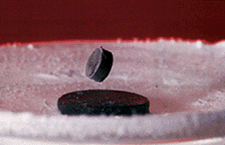The ongoing work at the Laboratory for Atomic Imaging Research is focused on the development of Scanning Probe Microscopy techniques and the application of these techniques to the study of nanotechnology and exotic condensed matter systems. Our group pursues a number of different inter-related research directions under the supervision of our principal investigators: Prof. Doug Bonn and Prof. Sarah Burke.
Professor Doug Bonn
High-Tc Superconductors
At the heart of our research program is materials development, as sample growth and characterization are key to our fundamental physics efforts. We have three laboratories devoted to materials: a solid state chemistry lab, a thin film lab, and a characterization lab featuring both a SQUID magnetometer and a Physical Properties Measurement System. Other materials facilities within AMPEL include a fully outfitted cleanroom and an X-ray crystallography lab. The materials aspect of our research affords students an opportunity to become involved in the chemistry as well as the physics of materials.

Our work on high-Tc superconductors focuses mainly on measuring the intrinsic properties of these materials in order to better understand the nature of the superconducting state and the pairing mechanism. We employ a wide range of magnetic (muon spin resonance, precision magnetization measurements, magneto-optic imaging) and microwave measurements (penetration depth, surface resistance, non-linear effects) to probe the superconducting state of our crystals, and collaborate with researchers worldwide in order to take advantage of a wide range of experimental techniques (PSI, LNCMI).
We have recently built a state-of-the-art facility in which we will make extensive use of scanning probe microscopy (SPM) techniques including atomic force microscopy (AFM) and scanning tunnelling microscopy (STM) in ultrahigh vacuum (UHV) and at low temperatures (~5K). This clean, low-temperature environment allows the characterization of well defined systems, with sufficiently high energy resolution for most organic and nanoscale systems of interest, and with the level of stability required to achieve measurements on individual nanostructures.
For additional information please visit: http://www.phas.ubc.ca/~supercon/index.html
Professor Sarah Burke
Organic thin film electronics

Organic thin film electronic and optoelectronic applications are emerging as exciting and promising technologies. However, there remain many questions, particularly regarding the influence of the device environment on the processes which give rise to the desired device functionality. In order to investigate the “organic film/gate dielectric” interface, prototype molecules on dielectric surfaces can be studied using non-contact AFM at the molecular/atomic scale to determine structure, as well as functionality through techniques such as Kelvin Probe Force Microscopy (KPFM). Also, the influence of different types of dielectric surfaces will be studied (e.g. ordered vs. amorphous surfaces) on the electronic structure and electrostatic environment on organic films and other nanomaterials such as graphene.
Nanoscale photovoltaics
Through collaboration with other researchers, STM and nc-AFM techniques will be used to characterize prototype nanoscale photovoltaic (PV) materials to understand the role of interfaces in key processes in charge generation, separation and transport. SPM techniques combined with optical excitation and spectroscopy require continued innovation in order to address this difficult, but important aspect of the development of alternative PV materials for clean energy.
Technique development
The development of techniques and progression of science go hand-in-hand. STM perhaps provides a particularly key example in that it helped to bring about the growth of nanoscience as an important new field in chemistry and physics as it made “seeing” at the nanoscale a reality. Conversely, the science STM enabled has pushed forward much of the development of STM and other scanned probe techniques. Technique development will be a key focus of my research, in particular towards improving understanding of KPFM on a variety of different materials and various modes of combined SPM-optical experiments.
For more information please visit: http://www.phas.ubc.ca/~saburke/index.html